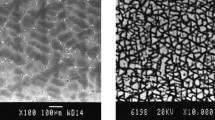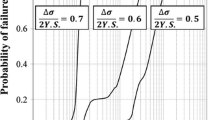Abstract
There would be considerable benefits in developing new structural materials where high use temperatures and strength coupled with low density are minimum capabilities. Nickel and titanium aluminides exhibit considerable potential for near-term application in various branches of modern industry due to the number of property advantages they possess including low density, high melting temperature, high thermal conductivity, and excellent environmental resistance, and their amenability for significant improvment in creep and fatigue resistance through alloying. Reliability of intermetallics when used as engineering materials has not yet been fully established. Ductility and fracture toughness at room and intermediate temperatures continue to be lower than the desired values for production implementation. In this paper, progress made towards improving strain-controlled fatigue resistance of nickel and titanium aluminides is outlined. The effects of manufacturing processes and micro alloying on low cycle fatigue behaviour of NiAl are addressed. The effects of microstructure, temperature of testing, section thickness, brittle to ductile transition temperature, mean stress and environment on fatigue behaviour of same γ-TiAl alloys are discussed.
Similar content being viewed by others
References
Anton D L, Shah D M 1990 Development potential of advanced intermetallic materials. Report: WRDC-TR-90-4112, Wright -Patterson Air Force Base, Dayton, OH
Bhanu Sankara Rao K 1989Influence of metallurgical variables on low cycle fatigue behaviour of type 304 stainless steel. Ph D thesis, University of Madras, Chennai
Bhanu Sankara Rao K, Lerch B A, Noebe R D 1994 Effects of micro alloying on the LCF behaviour of powder extruded NiAl. HITEMP Review-1994, NASA CP-10146: 53-1–53-11
Bhanu Sankara Rao K, Lerch B A, Noebe R D 1995 Effects of processing route on strain controlled low cycle fatigue behaviour of polycrystalline NiAl.Fatigue and fracture of ordered intermetallic materials II (eds) W O Soboyejo, T S Srivatsan, R O Ritchie (Warrendale, PA: Miner., Met. Mater. Soc.) pp 245–271
Christ H J, Fischer FOR, Maier H J 2001 High temperature fatigue behaviour of near y-TiAl alloy under isothermal and thermomechanical conditions.Mater. Sci. Eng. A329-331: 625–630
Christodoulou L, Parish P A, Crown C R 1988 In High temperature high performance compositesMRS Symposium Proceedings, (eds). F D Lemkeyet al (Pittsburgh, PA: Mater. Res. Soc.) vol. 120
Darolia R 1991 NiAl alloys for high temperature structural applications.J. Met. 43: 44–49
Darolia R 2000 Ductility and fracture toughness issues related to implementation of NiAl for gas turbine applications.Intermetallics 8: 1321–1327
Gregory J K1994 Fatigue crack propagation in titanium alloys.Handbook of fatigue crack propagation in metallic structures (ed.) A Carpinteri (Amsterdam: Elsevier) 1: 281–322
Kumar K S, Whittenberger J D 1992Mater. Sci. Technol. 8: 317–330
Lerch B A, Gerold V 1985 Room Temperature deformation mechanisms in Nimonic 80A,Acta Metall. 33: 1709–1716
Lerch B A, Noebe R D 1993 Low cycle fatigue behaviour of polycrystalline NiAl at 300 and 1000 K, NASA Lewis Research Center, NASA Technical, Cleveland, Ohio, Memorandum 105987.
Lerch B A, Noebe R D 1994 Low cycle fatigue behaviour of poly crystalline NiAl at 1000K.Metall. Mater. Trans. A, 25A: 309–319
Maier H J, Fischer FOR, Christ H J 2002 Environmental effects on the isothermal and thermomechanical fatigue behaviour of anear-γ titanium aluminide.Thermomechanicalfatigue behaviour of materials (eds) M A McGaw, S Kalluri, J Bressers, S D Peteves ASTM International, 4th volume, ASTM STP 1428 (in press)
Marbu C, Henaff G, Pettit J 1997 Environmental influence on fatigue crack propagation in TiAl alloys.Intermetallics 5: 305–360
Mediratta S R, Ramaswamy V, Rama Rao P 1986 Two stage cyclic work hardening and two-slope Coffin-Manson relationship in dual phase steels.Scr. Metall. 20: 555–560
Miracle D B 1993 The physical and mechanical properties of NiAl.Acta Metall. Mater. 41: 649–684
Noebe R D, Bowman R, Nathal M V 1993 Physical and mechanical properties of the B2 compound NiAl.Int. Mater. Rev. 38: 193–232
Noebe R D, Lerch B A, Bhanu Sankara Rao K 1995 Assessment of micro alloying effects on the high temperature fatigue behaviour of NiAl.Proc. Mater. Res. Soc. Sympo, Boston, 364: 291–296
Raj R 1978 Nucleation and growth of cavities at second phase particles in grain boundaries.Acta Metall. 26: 995–1005
Rao K T V, Ritchie R O 1998 High temperature fracture and fatigue resistance of a ductile β-TiNb Reinforced γ-TiAl intermetallic.Acta Mater. 46: 4167–4180
Recina V 2000 High temperature low cycle fatigue properties of two cast gamma titanium aluminide alloys with refined microstructure.Mater. Sci. Technol 16: 1–8
Recina V, Karlsson B 1999 High temperature low cycle fatigue properties of Ti-48Al-2W-0-5Si gamma titanium aluminide.Mat. Sci. Engg. A262: 70–81
Recina V, Remy L, Marchionni M, Guardamagna C 1998 Low cycle fatigue of theγ -based alloy Ti-48Al-2W-0-5Si, Materials for advanced power engineering.Proc. of 6th Liege Conference (eds) J L Beckers, F Schubert, P J Ennis, Part: 1259–1268
Rodriguez P, Bhanu Sankara Rao K 1993 Nucleation and growth of cracks and cavities under creepfatigue interaction.Prog. Mater. Sci. 37: 403–480
Sanders T H, Starke E A, Jr 1976Met. Trans. A7: 1107–1116
Schallow P, Christ H J 2002 High temperature fatigue of y-TiAl sheet material: A comparison with bulk material.Proc. Camp 2002, High temperature fatigue (eds) G Bathiaset al, pp 84–97
Valsan M, Bhanu Sankara Rao K, Mannan S L 1989 Effects of microstructure on elevated temperature LCF behaviour of Nimonic PE 16 superalloy.Trans. Indian Inst. Met. 42(suppl.): s203-s216
Wareing J, Tomkins B, Sumner G 1973 Fatigue at elevated temperatures. ASTM STP 520: 123–137
Author information
Authors and Affiliations
Rights and permissions
About this article
Cite this article
Rao, K.B.S. High temperature fatigue behaviour of intermetallics. Sadhana 28, 695–708 (2003). https://doi.org/10.1007/BF02706454
Issue Date:
DOI: https://doi.org/10.1007/BF02706454




